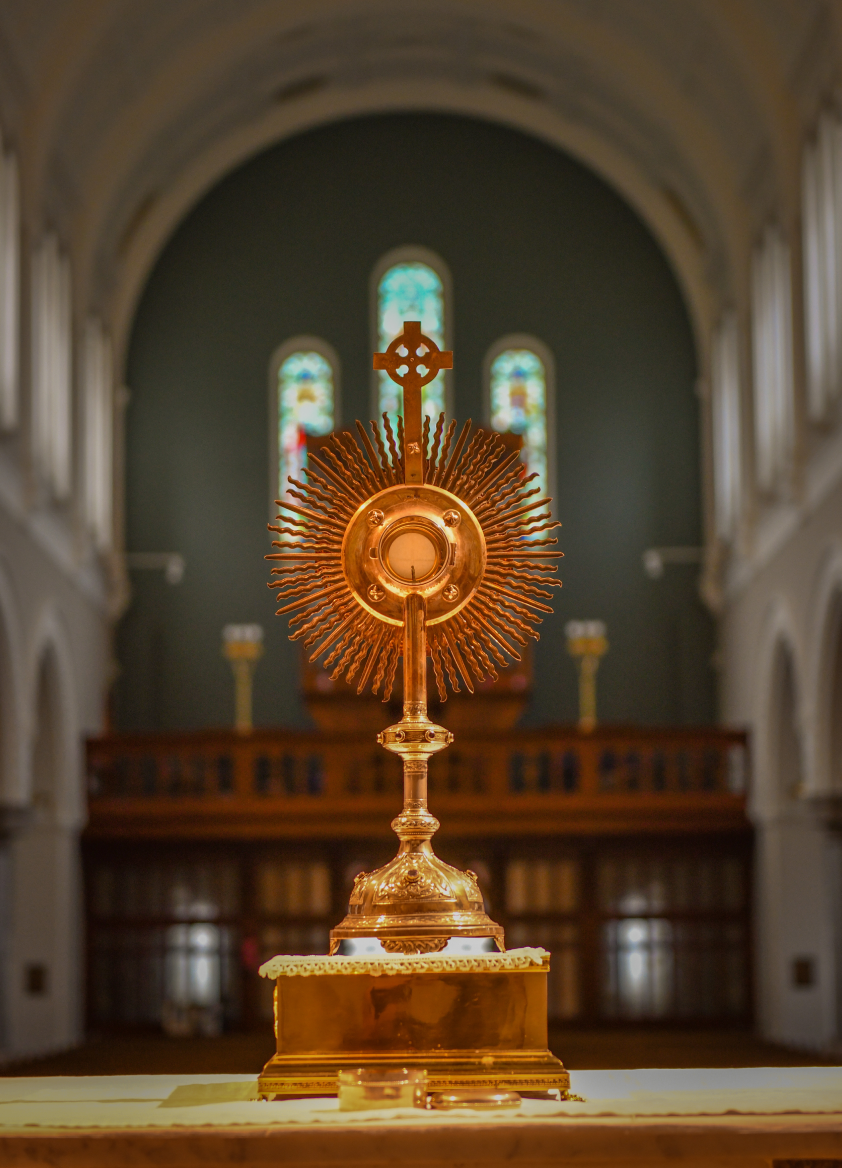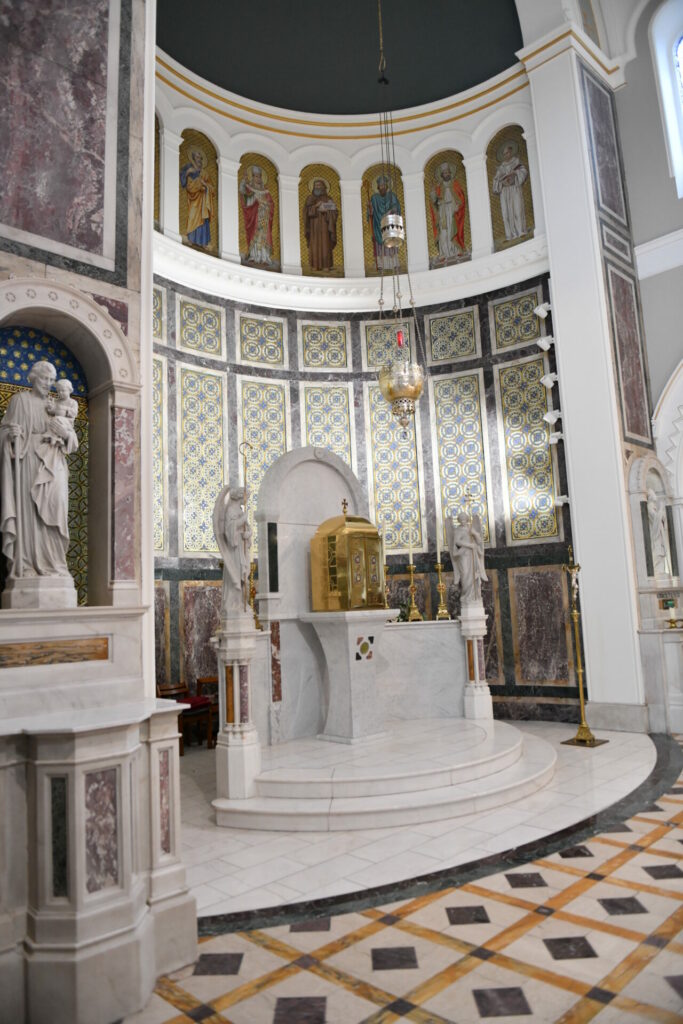Church Of St Malachy
- Home
- /
- Our Churches
- /
- Church Of St Malachy
Menu

St Patrick’s Cathedral
St Malachy’s Church
Church of St Colmcille
Church of the Immaculate Conception
Armagh Parish archives contain rather scant records regarding the building of this Church of St Malachy. Aside from a few newspaper accounts of the solemn opening of the church there are only a few papers together with a little notebook (detailing building costs, fund-raising and the various contractors engaged in the work) which belonged to Monsignor Eugene O’Callaghan, Administrator of the Parish when the church was built. When appointed Administrator in 1933 he was only too well aware that the days of the Old Chapel of St Malachy in Chapel Lane (erected in 1752) were numbered. On one occasion during Sunday Mass the leg of a parishioner in the gallery broke through the floor of her pew and caused a cascade of plaster and dust to fall on the heads of the congregation beneath. Despite pleas from the celebrant, Fr Joseph Pentony, CC, there was an irreverent and undecorous scramble for the door. Such incidents made it obvious to all that it was time for a change and so the decision was made to build a new more spacious church.

As the Parish owned a number of properties in Thomas Street at the time it was suggested that the church be located there, close to the reputed birthplace of St Malachy in nearby Ogle Street. Difficulties proved too much in getting all the property required freehold and so it was decided to look for alternative sites. Fr Arthur Toner CC approached two parishioners Frank Mallon and John Hanratty, business partners who had recently acquired a row of houses and an orchard in Lower Irish Street. The Parish duly purchased the entire property for £1,457 plus £61 auction fees and £59 solicitor’s fees.
The architects employed were the renowned firm of Ashlin & Coleman. 7 Dawson Street. Dublin, who received £700 in fees. The builders were P. McKenna & Sons, City Mills, Armagh, and Seatown Place, Dundalk, who were paid a total of £22,010 for the building, £750 for the main entrance and just over £60 for the demolition of the old houses on the street. £174 was paid for the boundary between the church and Corvans. The clerk of works on the site was James Mallon of Market Street and John Anthony McNally of Railway Street was foreman on site until the building reached window level.
Although work commenced on site in September 1934 the foundation stone was only laid a year later on the Sunday prior to 23rd October 1935. Apparently the foundation stone is on the right hand side above the main door. The inscription above the door reads + Sancte Malachia Ora Pro Nobis + and bears the date 1935.
The church was built in the Romanesque style with red brick on the inside and stone from the quarries at Navan on the outside. The nave barrel-vaulted ceiling (40 feet from the floor) was formed of timber ribs and plaster-board and the roof slated with Bangor blues. The building (152 feet long and 58 feet wide) was designed to seat 1200 people. The marble high altar (which cost £450), communion rail and steps (costing £350), baptismal font (donated by the Pioneer Total Abstinence Association), side altars, pulpit, and sanctuary floor were executed by the Dinelli Figli of Pietrasania near Carrara, Italy. The same firm also executed the beautiful Venetian mosaics in the apse and at the side altars. The Via Crucis (Stations of the Cross) costing £185 were made by the renowned Bavarian firm of Franz Mayer & Co. of Munich. Cardinal Joseph McRory donated the seating in the church at a cost of £1,700. Both he and Monsignor O’Callaghan took a great interest in the building, visiting the site from time to time to monitor progress.
Armagh was en fête with flags, banners and bunting on Sunday 25th September 1938 for the solemn dedication of the church by Cardinal McRory who presided at High Mass celebrated by Rt. Rev. Mgr. Eugene O’Callaghan (who had been appointed PP, St Peter’s Drogheda, Archdeacon and Vicar General of the Archdiocese the previous year). Rev, John Quinn CC acted as deacon, and Rev J.P. McNamara CM, St Patrick’s College was the Master of Ceremonies for the occasion. The Cardinal was assisted at the throne by two previous administrators of the Parish, Rt. Rev. Mgr. John Ward, PP, VF Magherafelt and Very Rev. Canon Patrick Finnegan, PP Donaghmore. Most Rev. Dr. Patrick Lyons, Bishop of Kilmore, gave the homily for the occasion which was attended by Bishop Daniel Mageean of Down & Connor, Bishop William MacNeely of Raphoe, Bishop Bernard O’Kane of Derry, Bishop Edward Mulhern of Dromore and a large concourse of priests and people. The altar boys were taken from St Patrick’s College, among who was one Thomas Fee (later to become Cardinal Tomas 6 Fiaich) who carried the holy water stoup for Cardinal McRory. The Cathedral Choir rendered the sacred music which included a special Mass of St Malachy composed by the Cathedral organist, Mr Thomas W. Holden. At the conclusion of the ceremony Very Rev. Joseph Pentony Adm. thanked all who had helped towards the erection of the church.
Following the Second Vatican Council’s Constitution on the Liturgy (Sacrosanctum concilium) reordering of the sanctuary was considered necessary. Fr Patsy McDonnell Adm. had the church repainted and renovations to the sanctuary commenced in May 1976 and were completed in time for Christmas of that same year.
On Wednesday, 28th September 1988, Armagh Parish formally marked the Golden Jubilee of St Malachy’s Church with a Mass of Thanksgiving celebrated by Cardinal Tomás Ó Fiaich and the priests of the Parish together with priest natives of the Parish, and priests who had served here. A new tabernacle and celebrant’s chair were provided when the church was redecorated during Fr Raymond Murray’s administratorship. Fr Richard Naughton Adm. oversaw the establishment of a Perpetual Adoration Chapel located in the old baptistery in 1986. He subsequently engaged Daly & O’Neill, Architects, of Portadown in 2001 to address the problem of dampness in the apse area of the church along with the installation of protective grills on the outside of the windows.
It was decided by the Parish Finance Committee and the Parish Buildings Committee that some renovation and redecoration of the church would commence after renovation work on the Cathedral had been completed. By 2004 it was advised that the original heating system was long past its life span and would need to be replaced and a complete rewiring of the church undertaken. These together with the provision of disabled access and toilet facilities at the rear of the church have all added greatly to the original estimate and scope of work outlined in 2003. The total cost of St Malachy’s Church together with the surrounding car park is just over £800,000.
Under the then Administrator, Fr Padraig Murphy, the members of the Finance Committee agreed that St Malachy’s should be completely renovated when the opportunity presented itself. And so Mr Dennis O’Neill of Daly & O’Neill, Architects, provided draft plans for the renovation which were discussed at length before being put on display in the church in July and August 2004. Over the past nine months the following works have been executed: Repairs were carried out to the plaster and damp proofed where necessary. Walls and ceilings were completely repainted. Carpets were removed from the aisles and ceramic tiles were repaired where necessary. The parquet block floor was sanded and re-varnished and the pews were also re-varnished and re-upholstered.
The marble and Venetian mosaic in sanctuary area was repaired and cleaned. The carpet on the sanctuary was removed and the marble floor reinstated and extended with new semi¬circle marble steps in front of the altar. A new reredos (comprising the two original pilasters with angels), tabernacle base, ambo and celebrant’s chair were also installed. The existing tabernacle base and ambo base were reinstated in their former location in front of the shrines of St Malachy and St Joseph respectively. A repository for the relic of St Malachy has been created at the base of his statue. The baptismal font was relocated off the centre aisle. The two confessionals at the rear of the church have been redesigned into shrines, one to St Therese and the other to St Anthony.
A complete rewiring and provision of a new lighting system (including new brass chandeliers in the side arches and up lighters on the ceiling) was undertaken. A new boiler was installed with a complete overhaul of the heating system (including a renewal of all under floor pipe work). The outside oil tank was replaced with an underground oil tank in the church grounds. A new PA system, fire detector/intruder alarm system was installed. New toilets have been provided near the front porch (including disabled toilet facilities). The sacristy complex has been redecorated, with a refurbishment of the toilet facility, storage space and a flower arranging room. The choir gallery access stairs and door were redesigned.

The exterior works carried out included: Repairs where necessary and storm glazing of all the stained glass windows. The front door steps were redesigned (with planters either side) to facilitate ramp access and a new hand-rail to the sacristy door steps. An electronic bell system has been installed in the original bell-cote and new paving has been provided in front of the church with new high kerbing and asphalt around church. New outside lighting (including flood lighting) has been installed. There is new fencing at the rear boundary of the church including two gates to the back car park. The grounds have also been landscaped.
Every effort has been made to enhance what is already a very beautiful and devotional church, one which is held dear by so many Armagh people. Hopefully, it will continue to be so in future generations.
Armagh’s Martyr
A plaque has been erected near the entrance of the church commemorating a native son of this Parish, Very Rev. James Hallegan (O’Fallegan) who was born in Ballyards, Milford, towards the end of the 161 century. He was educated for the priesthood on the continent and subsequently returned to the diocese. He was appointed Parish Priest of Armagh (the first since the Reformation) and Dean of the diocese in 1626. During a period of unrest in 1642 a large Scottish force was encamped in Legar Hill, Armagh. They plundered the district and put many of the inhabitants to the sword. They captured Dean Hallegan and another priest called Fr Hugh Quinn. Both were offered their lives if they would renounce their Catholic faith, but they refused to do so and were martyred.
.png)